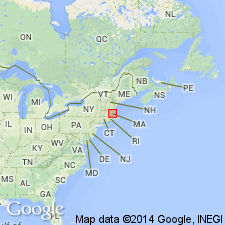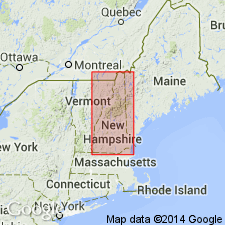
- Usage in publication:
-
- Exeter Diorite*
- Modifications:
-
- Age modified
- AAPG geologic province:
-
- New England province
Summary:
Exeter Diorite and Dracut Diorite assigned a Silurian and Devonian age on the basis of spatial association with Devonian Chelmsford Granite and probable Silurian Ayer Granite; older ages are possible for some masses. Gaudette and others (1975) suggest that the Exeter is same age (about 440 m.y.) as oldest part of "Hillsboro Plutonic Series" of southeastern NH and southwestern ME, placing it in the Early Silurian or Late Ordovician.
Source: GNU records (USGS DDS-6; Reston GNULEX).

- Usage in publication:
-
- Exeter Diorite
- Modifications:
-
- Not used
- AAPG geologic province:
-
- New England province
Summary:
Silurian and Devonian diorite and tonalite unit of Merrimack belt includes Dracut Diorite, tonalite near Ayer Granite, and equivalents of Exeter Diorite of NH. Intrudes Silurian Berwick Formation.
Source: GNU records (USGS DDS-6; Reston GNULEX).

- Usage in publication:
-
- Exeter Diorite*
- Modifications:
-
- Overview
- Age modified
- AAPG geologic province:
-
- New England province
Summary:
Used as Exeter Diorite. As mapped, includes associated intrusives of southeastern NH, pyroxene and pyroxene-hornblende diorite and gabbro, with minor granodiorite and granite. Age changed from Silurian and Devonian to Early Devonian based on a U/Pb date of 405 +/-1 Ma (Bothner and others, 1993, Zircon and sphene U/Pb ages of the Exeter pluton: Constraints on the Merrimack Group and part of the Avalon composite terrane [abs.]: Geological Society of America Abstracts with Programs, v. 25, p. 485; oral commun., 1994). Report includes geologic map and cross sections, and a derivative 1:500,000-scale showing plutons and isotopic dating sample localities and data.
Source: GNU records (USGS DDS-6; Reston GNULEX).
For more information, please contact Nancy Stamm, Geologic Names Committee Secretary.
Asterisk (*) indicates published by U.S. Geological Survey authors.
"No current usage" (†) implies that a name has been abandoned or has fallen into disuse. Former usage and, if known, replacement name given in parentheses ( ).
Slash (/) indicates name conflicts with nomenclatural guidelines (CSN, 1933; ACSN, 1961, 1970; NACSN, 1983, 2005, 2021). May be explained within brackets ([ ]).

